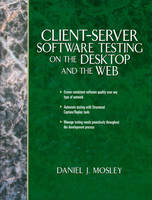
Client-Server Software Testing On The Desktop And The Web
Prentice Hall (Verlag)
978-0-13-183880-2 (ISBN)
- Titel ist leider vergriffen;
keine Neuauflage - Artikel merken
PLEASE PROVIDE
As more mission-critical applications are developed for client-server and Internet platforms, the demand for reliable test methods has soared. This is the first book to address the unique challenges of creating rigorous test routines that address the complexities of distributed computing. End-to-end coverage begins with the desktop GUI, moving through server and network concerns on up to cross-level functional testing, and system testing. A data-driven approach maximizes the opportunities for automation with Structured Capture/Replay tools. Guidelines are offered for choosing and implementing an automated test tool suite, and a special section addresses Y2K issues in testing PC and client-server software.
DANIEL J. MOSLEY graduated from the University of Missouri-Columbia and did his graduate work at St. Louis University. He has worked with information systems in the brewing, broadcasting, construction, financial, petroleum, publishing, and travel industries, and served on the faculty of Washington University in St. Louis. He is now president of Client Server Software Testing Technologies and author the The Handbook of MIS Application Software Testing in Prentice Hall's Yourdon Press Computing Series.
1. Client-Server Development Methods, Techniques, and Tools.
Introduction. Advantages and Disadvantages of Client-Server Computing. Defining Client-Server Computing. Client-Server Computing Requirements. Client-Server Architectures. Types of Client-Server Applications. Client-Server Versus Mainframe. The Layers of Client-Server Systems. C-S 2-Tier and 3-Tier Architectures. Conclusion. References.
2. Establishing Controls in a Client-Server Development Project.
Introduction. Client-Server Versus Traditional Application Development. Client-Server Systems Management. Client-Server Development Frameworks. CSIRD. The Impact on Testing. Conclusion. References.
3.Software Testing in the Client-Server Milieu.
Introduction. The QAI Software Testing Practices Survey. Problems with Testing Practice. Software Testing in the Distributed Processing Domain. A Client-Server Testing Methodology. Conclusion. References.
4. A Prescription for Planning, Executing, and Controlling the Testing Process.
Testing Approach. Testing Process. Overview. Software Testing Supporting Elements. A Defect Classification Framework. Some Notes on Test Planning. The Client-Server Test Plan: An Outline and Examples. Text-Rx Methodology: Steps and Activities. Resources for Software Testers on the Internet. Conclusion. References.
5. Testing Client Applications: Graphical User Interface Testing.
Introduction. The Elements of GUI Testing. Automated GUI Test Case Categories. Usability. Developing and Testing the GUI Prototype. GUI Reviews. GUI Test Tools. Conclusion. References.
6. Testing Server Applications.
Introduction. Error Trapping. Data Backup and Restoring Testing. Data Security Testing. Testing Replicated Data Integrity. Automated Server Testing Tools. Conclusion. References.
7. Testing Networked Applications.
Introduction. Common Sense Network Management. Modeling the Enterprise Network. A Proactive Network Testing Approach. Elements of Network Testing. The Client-Server LAN Recovery Test Plan. Network Management and Testing Tools. Conclusion. References.
8. Cross-Level Functional Testing: A Data-Driven Framework-Based Approach to Automated Testing.
Developing Automated Test Scripts. Recording vs. Programming Test Scripts. Managing Manual and Automated Test Scripts. Test Suite Maintenance. Data-Driven Testing. Structured Test Scripting. Writing Effective Test Scripts and Test Data. Functional Test Data Design. Requirements-Based Approaches. Hybrid Approaches. Code-Based Approaches. Code-Level Error Checking. Data-Driven Testing and Framework-Based Test Script Examples. Adding Controls to the Test Data. Conclusion. References.
9. Client-Server Software Testing Metrics: Cross-Level Technical Quality Assessment.
Introduction. Assessing Defect Trends. Test Coverage Metrics. Controlling the Testing Process. Assessing Software Release Readiness. IEEE Software Maturity Metric. Assessing Software Reliability. Benchmarking Client-Server System Performance. Some Miscellaneous Test Metrics. Conclusion. References.
10. Integration and System Testing on the Desktop.
Classical Integration Testing. Integration Testing in Client-Server Development. Classical System Testing. Developing System Test Cases. Establishing and Documenting the Expected Results. System Testing in the Client-Server Domain. System Testing and Automated Testing Tools. Documentation Testing. Commercially Available Help Authoring Tools. Conclusion. References.
11. Testing Webtop Client-Server Applications.
Testing Internet/Intranet Applications. Classes of Tests—The Internet GUI. Testing World Wide Web Pages. Types of Tests for Internet Applications. Webtop Testing Tools. Conclusion. References.
12. Year 2000 Testing.
Introduction. Y2K Issues. Levels of Y2K Tests. Y2K Test Planning. Client-Server Applications and Year 2000 Compliance. Year 2000 Testing Approach for Existing Client-Server. Client-Server Development Platforms and Y2K Compliance. PC and Unix Server Testing for Y2K Compliance. Y2K and PC Desktop Software. Year 2000 Desktop Remediation Process. Remediation Actions. Remediation Process. References.
13. Selecting an Automated Client-Server Software Testing Tool Suite.
Why Automate? Automated Test Tools. Automated Testing Tool Selection. Test Tool Selection Process Recommendations. Postselection Recommendations. Conclusion. References.
14. Software Testing Process Improvement: A Framework.
Introduction. Conclusion. References.
Index.
| Erscheint lt. Verlag | 2.9.1999 |
|---|---|
| Verlagsort | Upper Saddle River |
| Sprache | englisch |
| Maße | 184 x 243 mm |
| Gewicht | 908 g |
| Themenwelt | Geisteswissenschaften ► Psychologie ► Test in der Psychologie |
| Sozialwissenschaften ► Soziologie ► Empirische Sozialforschung | |
| ISBN-10 | 0-13-183880-6 / 0131838806 |
| ISBN-13 | 978-0-13-183880-2 / 9780131838802 |
| Zustand | Neuware |
| Haben Sie eine Frage zum Produkt? |
aus dem Bereich


